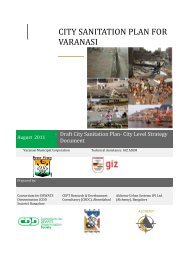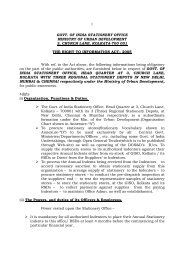- Page 1 and 2:
BAREILLY DRAFT CITY SANITATION PLAN
- Page 3 and 4:
3.2.G SANITATION FACILITIES AND SIT
- Page 5 and 6:
CITY SANITATION PLAN BAREILLY Consi
- Page 7 and 8:
1A_i 1A_ii City Sanitation Rating P
- Page 9 and 10:
1I 2A 2B disposed off City wastes c
- Page 11 and 12:
2F 2G Percentage of Cost Recovery f
- Page 13 and 14:
CITY SANITATION PLAN BAREILLY The f
- Page 15 and 16:
CITY SANITATION PLAN BAREILLY Profi
- Page 17 and 18:
CITY SANITATION PLAN BAREILLY susta
- Page 19 and 20:
CITY SANITATION PLAN BAREILLY under
- Page 21 and 22:
CITY SANITATION PLAN BAREILLY S.NO.
- Page 23 and 24:
CITY SANITATION PLAN BAREILLY Sens
- Page 25 and 26:
1. Residents including slum residen
- Page 27 and 28:
INTRODUCTION CITY SANITATION PLAN B
- Page 29 and 30:
CITY SANITATION PLAN BAREILLY of Ja
- Page 31 and 32:
CITY SANITATION PLAN BAREILLY playe
- Page 33 and 34:
CITY SANITATION PLAN BAREILLY facto
- Page 35 and 36:
CITY SANITATION PLAN BAREILLY No p
- Page 37 and 38:
CITY SANITATION PLAN BAREILLY In or
- Page 39:
Nagar Nigam Bareilly (NNB) : The ad
- Page 43 and 44:
KEY ISSUES The critical issues that
- Page 45 and 46:
CITY SANITATION PLAN BAREILLY Spat
- Page 47 and 48:
CITY SANITATION PLAN BAREILLY servi
- Page 49 and 50: CITY SANITATION PLAN BAREILLY The f
- Page 51 and 52: CITY SANITATION PLAN BAREILLY The f
- Page 53 and 54: Treated Water Quality Surveillance
- Page 55 and 56: CITY SANITATION PLAN BAREILLY Class
- Page 57 and 58: CITY SANITATION PLAN BAREILLY The f
- Page 59 and 60: Ward/ Zone Zone - 1 Zone - 2 Zone -
- Page 61 and 62: The following table illustrates the
- Page 63 and 64: CITY SANITATION PLAN BAREILLY Class
- Page 65 and 66: CITY SANITATION PLAN BAREILLY Ward-
- Page 67 and 68: Ward-49 Rhapura Choudry CITY SANITA
- Page 69 and 70: Waste Generated by Markets (Vegetab
- Page 71 and 72: Staff Information CITY SANITATION P
- Page 73 and 74: The drain silt constitutes about 15
- Page 75 and 76: CITY SANITATION PLAN BAREILLY menti
- Page 77 and 78: CITY SANITATION PLAN BAREILLY Total
- Page 79 and 80: CITY SANITATION PLAN BAREILLY bad c
- Page 81 and 82: CITY SANITATION PLAN BAREILLY tanks
- Page 83 and 84: CITY SANITATION PLAN BAREILLY 7. 50
- Page 85 and 86: schemes of town planning and design
- Page 87 and 88: CITY SANITATION PLAN BAREILLY and d
- Page 89 and 90: CITY SANITATION PLAN BAREILLY The a
- Page 91 and 92: CITY SANITATION PLAN BAREILLY The a
- Page 93 and 94: CITY SANITATION PLAN BAREILLY The a
- Page 95 and 96: CITY SANITATION PLAN BAREILLY use.
- Page 97 and 98: CITY SANITATION PLAN BAREILLY MT/ D
- Page 99: CITY SANITATION PLAN BAREILLY The d
- Page 103 and 104: SANITATION FACILITIES AND SITUATION
- Page 105 and 106: CITY SANITATION PLAN BAREILLY The a
- Page 107 and 108: CITY SANITATION PLAN BAREILLY stren
- Page 109 and 110: CITY SANITATION PLAN BAREILLY elect
- Page 111 and 112: CITY SANITATION PLAN BAREILLY Even
- Page 113 and 114: CITY SANITATION PLAN BAREILLY about
- Page 115 and 116: IEC AND AWARENESS ISSUES Open Defec
- Page 117 and 118: Slums Inner City Nadaushi, Veer Bha
- Page 119 and 120: CITY SANITATION PLAN BAREILLY their
- Page 121 and 122: CITY SANITATION PLAN BAREILLY that
- Page 123 and 124: Solid Waste Management Key Issues:
- Page 125 and 126: CITY SANITATION PLAN BAREILLY Ther
- Page 127 and 128: 9. No provision of community/ publi
- Page 129 and 130: CITY SANITATION PLAN BAREILLY 11. A
- Page 131 and 132: CITY SANITATION PLAN BAREILLY The
- Page 133 and 134: CITY SANITATION PLAN BAREILLY deman
- Page 135 and 136: Corporators, office bearers of Slum
- Page 137 and 138: Don’t share clothes of persons in
- Page 139 and 140: CITY SANITATION PLAN BAREILLY The e
- Page 141 and 142: CITY SANITATION PLAN BAREILLY oppor
- Page 143 and 144: CITY SANITATION PLAN BAREILLY SWOT
- Page 145 and 146: CITY SANITATION PLAN BAREILLY SWOT
- Page 147 and 148: CITY SANITATION PLAN BAREILLY techn
- Page 149 and 150: CITY SANITATION PLAN BAREILLY sludg
- Page 151 and 152:
CITY SANITATION PLAN BAREILLY The S
- Page 153 and 154:
CITY SANITATION PLAN BAREILLY The D
- Page 155 and 156:
CITY SANITATION PLAN BAREILLY or re
- Page 157 and 158:
Pros and Cons CITY SANITATION PLAN
- Page 159 and 160:
CITY SANITATION PLAN BAREILLY the s
- Page 161 and 162:
CITY SANITATION PLAN BAREILLY Requ
- Page 163 and 164:
CITY SANITATION PLAN BAREILLY havin
- Page 165 and 166:
SL.NO FINANCING SOURCE APPROACH 1 1
- Page 167 and 168:
CITY SANITATION PLAN BAREILLY ADMIN
- Page 169 and 170:
ILCS Scheme Details: CITY SANITATIO
- Page 171 and 172:
6.3.3 COMPARATIVE ASSESSMENT OF OPT
- Page 173 and 174:
CITY SANITATION PLAN BAREILLY peopl
- Page 175 and 176:
CITY SANITATION PLAN BAREILLY ADMIN
- Page 177 and 178:
CITY SANITATION PLAN BAREILLY The r
- Page 179 and 180:
CITY SANITATION PLAN BAREILLY be in
- Page 181 and 182:
Elected representatives Sanitation
- Page 183 and 184:
CITY SANITATION PLAN BAREILLY ADMIN
- Page 185 and 186:
State Government Urban Development
- Page 187 and 188:
CITY SANITATION PLAN BAREILLY Secto
- Page 189 and 190:
CITY SANITATION PLAN BAREILLY ADMIN
- Page 191 and 192:
Bio-Medical Waste Nagar Nigam/Healt
- Page 193 and 194:
CITY SANITATION PLAN BAREILLY 3 The
- Page 195 and 196:
6.3.6 LINKAGE WITH STATE SANITATION
- Page 197 and 198:
Outcome Related CITY SANITATION PLA
- Page 201 and 202:
Conclusion CITY SANITATION PLAN BAR
- Page 203 and 204:
CITY SANITATION PLAN BAREILLY will
- Page 205 and 206:
ROAD MAP CITY SANITATION PLAN BAREI
- Page 207 and 208:
CITY SANITATION PLAN BAREILLY Docu
- Page 209 and 210:
campaign this can be achieved over
- Page 211 and 212:
CITY SANITATION PLAN BAREILLY have
- Page 213 and 214:
CITY SANITATION PLAN BAREILLY work
- Page 215 and 216:
CITY SANITATION PLAN BAREILLY MRTS,
- Page 217 and 218:
CITY SANITATION PLAN BAREILLY Kalya
- Page 219 and 220:
REFERENCES APPENDIX CITY SANITATION
















